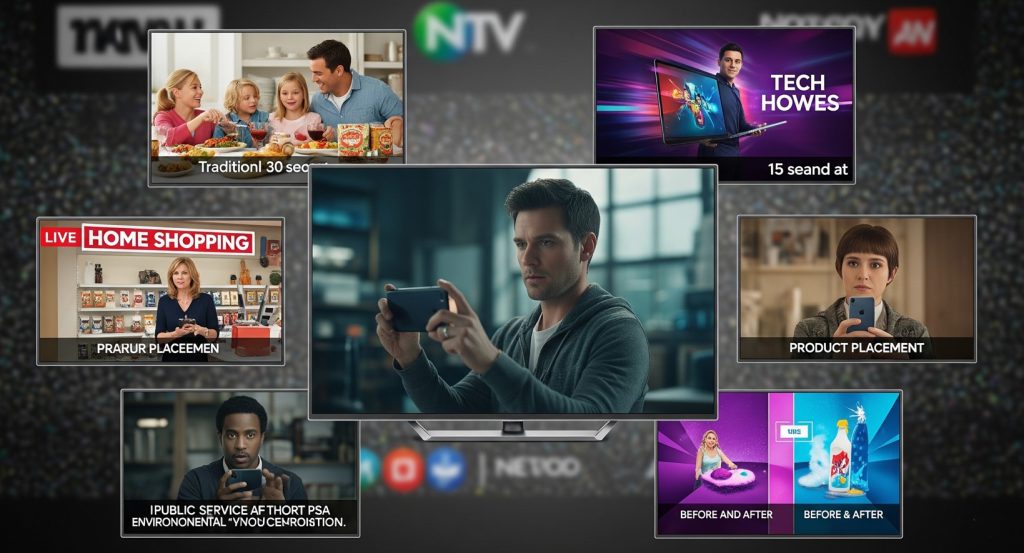Television advertising remains one of the most powerful ways to reach mass audiences and build brand awareness. Despite the rise of digital platforms, TV commercials continue to drive significant results for businesses of all sizes, from local retailers to global corporations.
While television advertising might seem complex and expensive, understanding the process can help you determine whether it’s right for your business. This comprehensive guide will walk you through everything you need to know about advertising on television, from planning your campaign to measuring its success.
Understanding Television Advertising Basics
Television advertising involves purchasing airtime to broadcast your commercial message to viewers. Unlike digital advertising, where you can target specific demographics with precision, TV advertising reaches broader audiences within specific time slots and programs.
The power of television lies in its ability to combine visual storytelling with audio messaging, creating emotional connections that drive brand recall and consumer action. TV commercials can demonstrate products, showcase brand personality, and create memorable moments that stick with viewers long after they’ve seen your ad.
Television advertising works best for businesses with broader market appeal, sufficient budget for production and media buying, and clear messaging that resonates with general audiences. It’s particularly effective for building brand awareness, launching new products, and reaching demographics that may be harder to target through digital channels.
Types of Television Advertising

National Television Advertising
National TV advertising involves purchasing airtime on major networks like ABC, CBS, NBC, and Fox. These campaigns reach millions of viewers across the country but require substantial budgets, often ranging from hundreds of thousands to millions of dollars.
National campaigns work best for large companies with nationwide distribution, significant advertising budgets, and products or services that appeal to broad demographics. The high cost means every element of your campaign must be carefully planned and executed.
Local Television Advertising
Local TV advertising focuses on specific geographic markets, allowing businesses to reach customers in their immediate area. Local stations offer more affordable rates and flexible scheduling options, making television accessible to smaller businesses.
Local campaigns excel for restaurants, retail stores, service providers, and other businesses that serve specific communities. You can target viewers in your city or region while building local brand recognition and driving foot traffic to physical locations.
Cable Television Advertising
Cable networks offer targeted advertising opportunities at lower costs than broadcast television. With hundreds of channels covering specific interests and demographics, cable advertising lets you reach more focused audiences.
Cable advertising works well for businesses targeting specific age groups, interests, or lifestyles. Whether you’re targeting sports fans, news viewers, or entertainment audiences, cable networks provide options for reaching your ideal customers.
Streaming and Connected TV Advertising
Streaming platforms and connected TV services now offer advertising opportunities that combine television’s visual impact with digital targeting capabilities. These platforms let you reach cord-cutters and younger demographics who may not watch traditional television.
Connected TV advertising provides detailed analytics and targeting options while maintaining the credibility and impact of television advertising. It’s particularly valuable for reaching younger audiences and tech-savvy consumers.
Planning Your Television Advertising Campaign

Setting Clear Objectives
Define specific goals for your television advertising campaign before creating content or purchasing airtime. Whether you want to increase brand awareness, drive sales, promote a specific product, or build market share, clear objectives guide every decision in your campaign.
Establish measurable targets like increased website traffic, phone calls, store visits, or sales during and after your campaign. These metrics help you evaluate success and optimize future television advertising efforts.
Identifying Your Target Audience
Understanding your ideal customer helps you select the right programs, time slots, and messaging for your television campaign. Consider demographics like age, income, interests, and viewing habits when planning your approach.
Research shows that different programs attract distinct audiences. News programs tend to attract older, more affluent viewers, while entertainment shows may reach younger demographics. Sports programming often attracts male viewers, while daytime television typically reaches women.
Budgeting for Television Advertising
Television advertising costs include both production expenses and media buying fees. Production costs vary dramatically based on complexity, talent, location, and production quality. Simple local commercials might cost a few thousand dollars, while national campaigns can require millions.
Media buying costs depend on the market size, time slot, program popularity, and competition for advertising space. Prime time slots cost significantly more than daytime or late-night advertising, but they also reach larger audiences.
Creating Effective Television Commercials
Developing Your Message
Your television commercial must communicate your key message within 15, 30, or 60 seconds. Focus on one primary benefit or call-to-action rather than trying to cover multiple points. Viewers need to understand and remember your message immediately.
Start with a compelling hook that grabs attention within the first few seconds. Use clear, simple language that your target audience understands. End with a strong call-to-action that tells viewers exactly what you want them to do.
Visual and Audio Elements
Television advertising combines sight and sound to create memorable experiences. Use high-quality visuals that support your message and reflect your brand image. Poor production quality can damage credibility and reduce effectiveness.
Audio elements include voiceovers, music, and sound effects. Choose voices that match your brand personality and resonate with your target audience. Background music should enhance your message without overwhelming it.
Production Considerations
Professional production significantly impacts your commercial’s effectiveness. Work with experienced producers, directors, and editors who understand television advertising requirements and can bring your vision to life.
Consider technical requirements like aspect ratios, audio levels, and file formats required by different networks and stations. Ensure your commercial meets broadcast standards and looks professional on various screen sizes.
Buying Television Advertising Time
Understanding Ratings and Reach
Television advertising purchases are based on ratings points and reach metrics. Ratings measure the percentage of households watching a specific program, while reach indicates how many different people see your commercial.
Gross Rating Points (GRPs) multiply reach by frequency to show total advertising exposure. Higher GRPs generally cost more but provide greater exposure for your message. Work with media buyers to find the right balance for your budget and objectives.
Negotiating Media Rates
Television advertising rates are negotiable, especially for local markets and extended campaigns. Stations often offer package deals, frequency discounts, and added value opportunities that can stretch your budget further.
Consider factors like program content, audience demographics, time slots, and seasonal demand when negotiating rates. Building relationships with station representatives can lead to better rates and prime placement opportunities.
Timing and Scheduling
When you advertise affects both cost and effectiveness. Prime time slots (typically 8-11 PM) reach the largest audiences but cost significantly more than daytime or late-night slots.
Consider your target audience’s viewing habits when scheduling commercials. If you’re targeting working professionals, evening slots might work better than daytime advertising. For reaching retirees or stay-at-home parents, daytime slots could be more effective and affordable.
Measuring Television Advertising Success

Tracking Campaign Performance
Monitor key performance indicators during and after your television campaign. Track metrics like website traffic, phone calls, store visits, and sales to measure direct response to your advertising.
Use unique phone numbers, website URLs, or promo codes in your commercials to track responses directly attributable to television advertising. This data helps you calculate return on investment and optimize future campaigns.
Analyzing Audience Response
Pay attention to audience feedback through social media, customer comments, and brand recognition surveys. Television advertising often generates buzz and conversation that extends beyond direct sales impact.
Monitor brand awareness metrics before, during, and after your campaign to measure its impact on market perception. Increased brand recognition can lead to long-term sales growth even if immediate response is limited.
Optimizing Future Campaigns
Use performance data to improve subsequent television advertising efforts. Identify which messages, time slots, and programs generated the best results for your business.
Test different approaches in future campaigns. Try varying your message, creative execution, or media placement to find the most effective combination for your target audience and objectives.
Common Television Advertising Mistakes
Many businesses make critical errors that reduce their television advertising effectiveness. Avoid creating commercials that try to communicate too many messages at once, which can confuse viewers and dilute your impact.
Don’t underestimate production quality. Poor audio, unclear visuals, or amateur execution can damage your brand credibility and waste your media investment. Invest in professional production that reflects your brand standards.
Never run television advertising without clear tracking mechanisms. Without proper measurement, you can’t determine whether your campaign generated positive returns or identify areas for improvement.
Alternative Television Advertising Options
Sponsorships and Partnerships
Consider sponsoring specific programs, weather segments, or news features instead of traditional commercial placement. Sponsorships can provide extended exposure and association with trusted content.
Program sponsorships often include mentions during the show, logo placement, and promotional opportunities that extend your advertising impact beyond traditional commercial breaks.
Infomercials and Long-Form Content
Long-form commercials allow detailed product demonstrations and comprehensive messaging that’s impossible in standard commercials. Infomercials work particularly well for products requiring explanation or demonstration.
These formats provide time to address objections, showcase testimonials, and include multiple calls-to-action. They’re especially effective for direct-response marketing and complex products or services.
Making Television Advertising Work for Your Business
Television advertising success requires strategic planning, professional execution, and careful measurement. Start with clear objectives, understand your target audience, and create compelling messages that resonate with viewers.
Work with experienced professionals who understand television advertising requirements and can help you navigate the complex process of production and media buying. Their expertise can help you avoid costly mistakes and maximize your campaign effectiveness.
To build a strong promotional strategy, it’s important to understand how to advertise on television effectively while also learning how to market your product successfully across different channels.





